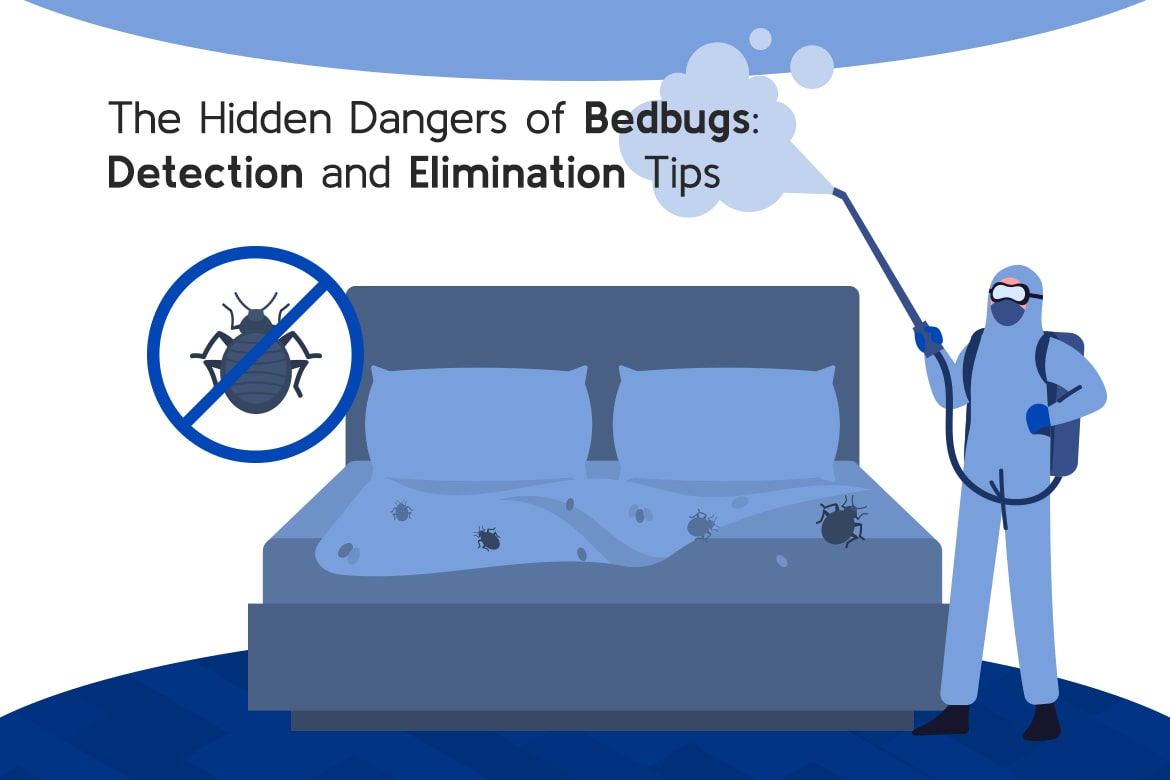Bedbugs, the small but notorious pests, can wreak havoc on your home and well-being. This blog help you understand the significance of timely detection and effective elimination. Bedbugs are more common than you might think, and their presence can severely impact your health and comfort. By recognizing the signs and taking prompt action, you can prevent an infestation from escalating and protect your living environment.
Understanding Bedbugs
Bedbugs are tiny, oval-shaped insects that feed on the blood of humans and animals. Adult bedbugs are about the size of an apple seed, measuring 5-7 mm in length. They are reddish-brown in colour and become engorged after feeding, which causes them to appear darker. Bedbugs undergo several stages of development, from eggs to nymphs to adults. Female bedbugs can lay hundreds of eggs in their lifetime, making infestations challenging to control once established.
These pests are elusive and often hide in various parts of your home. Common hiding spots include:
- Mattresses and box springs: Bedbugs prefer to stay close to their food source, making beds a prime location.
- Furniture: Bedbugs can hide in the seams and folds of chairs, couches, and other upholstered furniture.
- Cracks and crevices: They often nest in the crevices of walls, baseboards, and floorboards.
- Carpets and rugs: Bedbugs can live in the fibres of carpets, particularly along the edges and under furniture.
- Electrical outlets and appliances: These pests can even hide behind electrical outlet covers and inside appliances.
Bedbugs spread through direct contact and by hitching rides on luggage, clothing, and used furniture. They are also known to travel between rooms and apartments in multi-unit buildings, making it essential to address infestations promptly.
Understanding the behaviour and biology of bedbugs is crucial for effective detection and elimination. Being aware of their common hiding spots and how they spread can help you take proactive measures to prevent and control infestations.
The Hidden Dangers of Bedbug Infestations
Bedbug infestations pose significant threats beyond just being a nuisance. Understanding the hidden dangers associated with these pests is crucial for maintaining health, comfort, and overall well-being.
a) Health Risks Associated with Bedbugs
- Allergic Reactions to Bites: Bedbug bites can cause severe allergic reactions in some individuals. These bites often result in red, itchy welts on the skin, which can become inflamed and uncomfortable. In extreme cases, people may experience anaphylaxis, a severe allergic reaction that requires immediate medical attention.
- Secondary Infections from Scratching: The intense itching caused by bedbug bites can lead to excessive scratching, breaking the skin, and increasing the risk of secondary infections. Open wounds from scratching can become infected with bacteria, leading to further complications and requiring medical treatment.
- Mental Health Impacts: Bedbug infestations can significantly affect mental health. The stress and anxiety of dealing with an infestation, combined with the physical discomfort of bites, can lead to sleep disturbances and insomnia. The constant worry and lack of restful sleep can exacerbate feelings of stress and anxiety, impacting overall mental well-being.
b) Impact on Property and Quality of Life
- Potential Damage to Furniture and Personal Belongings: Bedbugs can infest various items in your home, including mattresses, furniture, and personal belongings. Over time, their presence can cause damage to these items. Infested furniture may need to be discarded, leading to the loss of valuable possessions and the need for costly replacements.
- Financial Costs of Treatment and Replacement: Addressing a bedbug infestation can be financially burdensome. Professional extermination services can be expensive, especially if multiple treatments are required. Additionally, replacing infested furniture, bedding, and other personal items can add to the overall cost, making bedbug infestations a significant financial strain.
Signs of Bedbug Infestations
Early detection of bedbug infestations is key to preventing extensive damage and mitigating health risks. Here are some common signs of bedbug activity to watch for:
- Bite Marks on the Skin: Bedbug bites often appear as small, red welts on the skin, usually in a linear or clustered pattern. These bites are typically found on exposed areas of the body, such as the face, neck, arms, and legs. The bites can be extremely itchy and may cause a burning sensation.
- Visual Evidence: Bedbugs are small and can be difficult to spot, but they leave behind telltale signs. Look for live bedbugs, which are reddish-brown and about the size of an apple seed. Additionally, check for shed skins, which are translucent and indicate that bedbugs have moulted as they grow.
- Dark Spots on Bedding and Furniture: Bedbug faeces appear as small, dark spots on bedding, mattresses, and furniture. These spots are a result of digested blood and can be found in areas where bedbugs are hiding. Blood stains from crushed bedbugs may also be visible on sheets and pillowcases.
Being vigilant and recognizing these signs early can help you take swift action to address a bedbug infestation. In the next section, we will discuss effective detection methods and practical tips for eliminating bedbugs, ensuring a pest-free home and peace of mind.
Effective Detection Methods
Detecting bedbugs early is crucial for effective elimination. Here’s how you can thoroughly inspect your home and the benefits of professional detection services.
a) Tips for Conducting a Thorough Inspection
- Checking Mattresses, Box Springs, and Bed Frames: Start by stripping your bed and inspecting the seams, tufts, and folds of your mattress and box spring. Bedbugs often hide in these areas. Also, examine the bed frame, paying special attention to cracks and crevices.
- Inspecting Furniture, Carpets, and Baseboards: Bedbugs can hide in more than just your bed. Check upholstered furniture, particularly in seams and cushions. Inspect carpets, especially along the edges and baseboards, where bedbugs might hide. Don’t forget to look behind picture frames and under loose wallpaper.
- Using Tools Like Flashlights and Magnifying Glasses: To see bedbugs more clearly, use a flashlight to illuminate dark areas and a magnifying glass to get a closer look. These tools can help you spot tiny bedbugs and their eggs, which are often difficult to see with the naked eye.
b) Professional Detection Services
- Benefits of Professional Inspections: Professionals have the experience and knowledge to identify bedbug infestations accurately. They know where to look and what signs to identify, which can save you time and ensure a thorough inspection.
- Advanced Detection Methods: Professional pest control companies often use advanced detection methods. Canine inspections, for example, employ trained dogs that can sniff out bedbugs with high accuracy. Specialized equipment, such as bedbug detection monitors, can also be used to confirm the presence of bedbugs.
Elimination Tips for Bedbug Infestations
Once bedbugs are detected, swift and effective action is necessary. Here are some DIY methods and professional services to consider.
a) DIY Bedbug Treatment Options
- Vacuuming and Steam Cleaning: Regular vacuuming can help remove bedbugs and their eggs from surfaces. Use a vacuum with a HEPA filter and dispose of the vacuum bag immediately. Steam cleaning is also effective, as high temperatures can kill bedbugs on contact. Focus on mattresses, furniture, and carpets.
- Using Bedbug-Proof Mattress Encasements: Encase your mattress and box spring in bedbug-proof encasements. These specially designed covers trap any existing bedbugs inside, preventing them from feeding and eventually killing them. They also prevent new infestations from taking hold.
- Natural Remedies: Diatomaceous earth, a natural powder, can be sprinkled around infested areas. It works by dehydrating and killing bedbugs. Essential oils like tea tree oil and lavender oil can also be used as repellents. However, their effectiveness may vary, and they should be used as part of a broader treatment plan.
b) Professional Extermination Services
- Overview of Chemical Treatments and Heat Treatments: Professional exterminators may use chemical treatments that are highly effective against bedbugs. Heat treatments, which involve raising the temperature of the affected area to lethal levels, can also be used. Both methods require specialized equipment and expertise.
- Importance of Hiring Licensed and Experienced Pest Control Professionals: Dealing with bedbugs is complex and often requires professional intervention. Licensed and experienced pest control professionals have access to more potent treatments and the knowledge to apply them safely and effectively.
- How MET Pest Control Handles Bedbug Infestations: MET Pest Control offers comprehensive bedbug management solutions. Our team conducts thorough inspections using advanced detection methods and tailors treatment plans to the severity of the infestation. We use a combination of chemical and heat treatments to ensure complete eradication of bedbugs and provide follow-up services to prevent reinfestations.
Preventing Future Bedbug Infestations
Preventing bedbug infestations requires ongoing vigilance and proactive measures. Here are some tips and strategies to keep these unwelcome pests out of your home.
a) Tips for Preventing Bedbugs from Entering Your Home
- Regularly Inspecting Second-Hand Furniture and Clothing: Before bringing any second-hand items into your home, thoroughly inspect them for signs of bedbugs. Pay close attention to seams, folds, and crevices in furniture and clothing. Washing and drying second-hand clothing on high heat can also help kill any hidden bedbugs.
- Using Protective Covers on Mattresses and Pillows: Encase your mattresses and pillows in bedbug-proof covers. These protective covers create a barrier that prevents bedbugs from getting into or out of your bedding, making it easier to detect and eliminate infestations.
- Reducing Clutter to Minimize Hiding Spots: Bedbugs love to hide in cluttered areas. By reducing clutter, especially in bedrooms and living areas, you can minimize potential hiding spots for bedbugs. Regular cleaning and organizing can help keep your home less attractive to these pests.
b) Ongoing Vigilance and Proactive Measures
- Routine Inspections and Maintenance: Regularly inspect your home for signs of bedbugs, even if you haven’t noticed any activity. Pay special attention to bedrooms, furniture, and areas where people rest or sleep. Routine maintenance, such as sealing cracks and crevices, can also help prevent bedbugs from finding entry points into your home.
- Educating Household Members About Bedbug Prevention: Educate everyone in your household about the importance of bedbug prevention. Teach them how to identify signs of bedbugs and the steps to take if they suspect an infestation. This collective vigilance can help catch potential infestations early.
Bedbugs are a persistent and challenging pest that can significantly impact health and comfort. Timely detection and effective elimination are crucial for maintaining a pest-free home. Prevention is equally important to avoid future infestations. Professional pest control services provide comprehensive solutions that are often more effective than DIY methods. Experts have the knowledge, experience, and tools necessary to address bedbug infestations thoroughly and prevent them from recurring.
Don’t let bedbugs disrupt your peace of mind. If you suspect a bedbug infestation, don’t wait. Contact MET Pest Control for expert bedbug detection and elimination services. Our team is dedicated to providing thorough, effective, and eco-friendly solutions to keep your home bedbug-free. Schedule your inspection today and ensure a safe, comfortable environment for you and your family.

